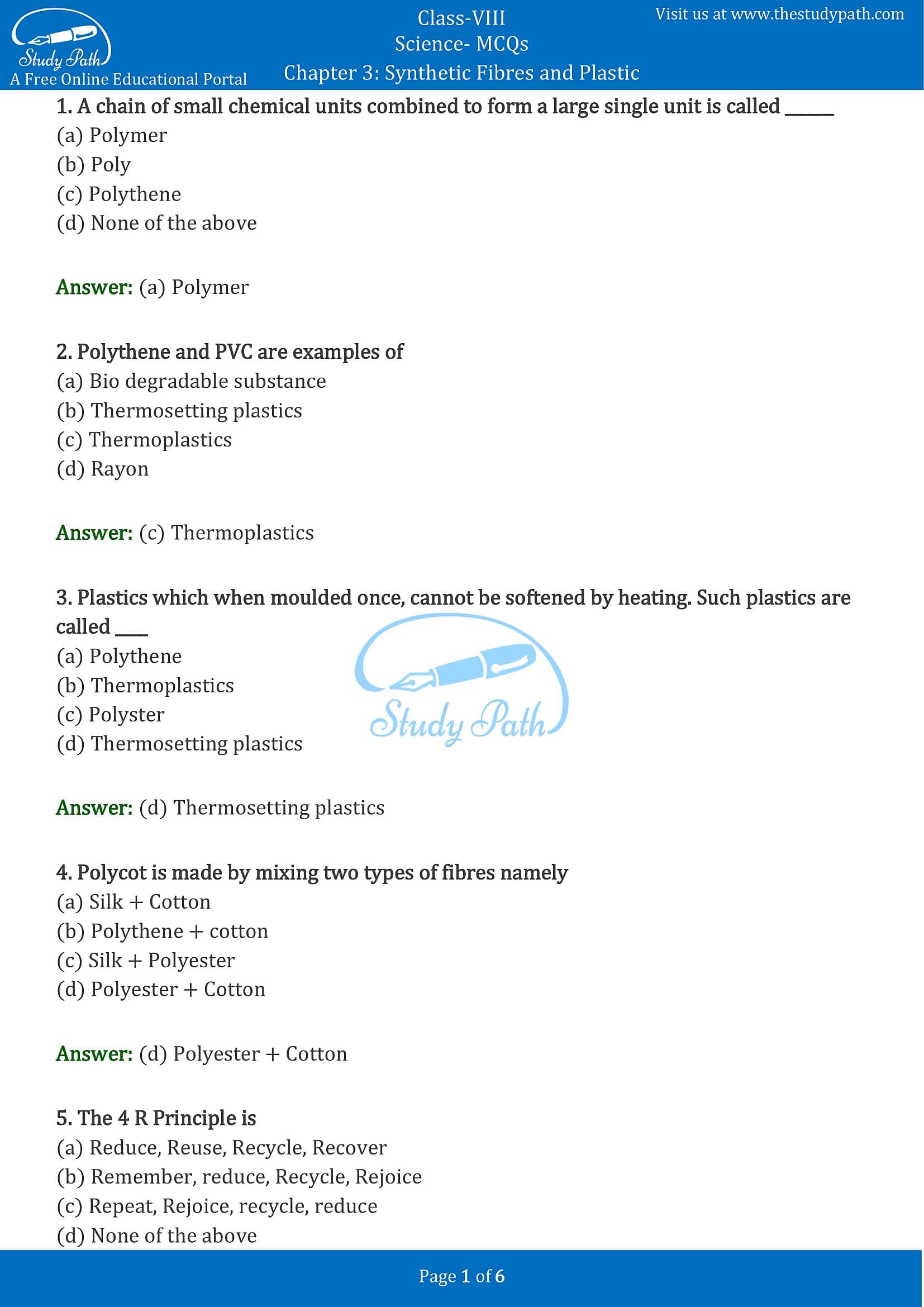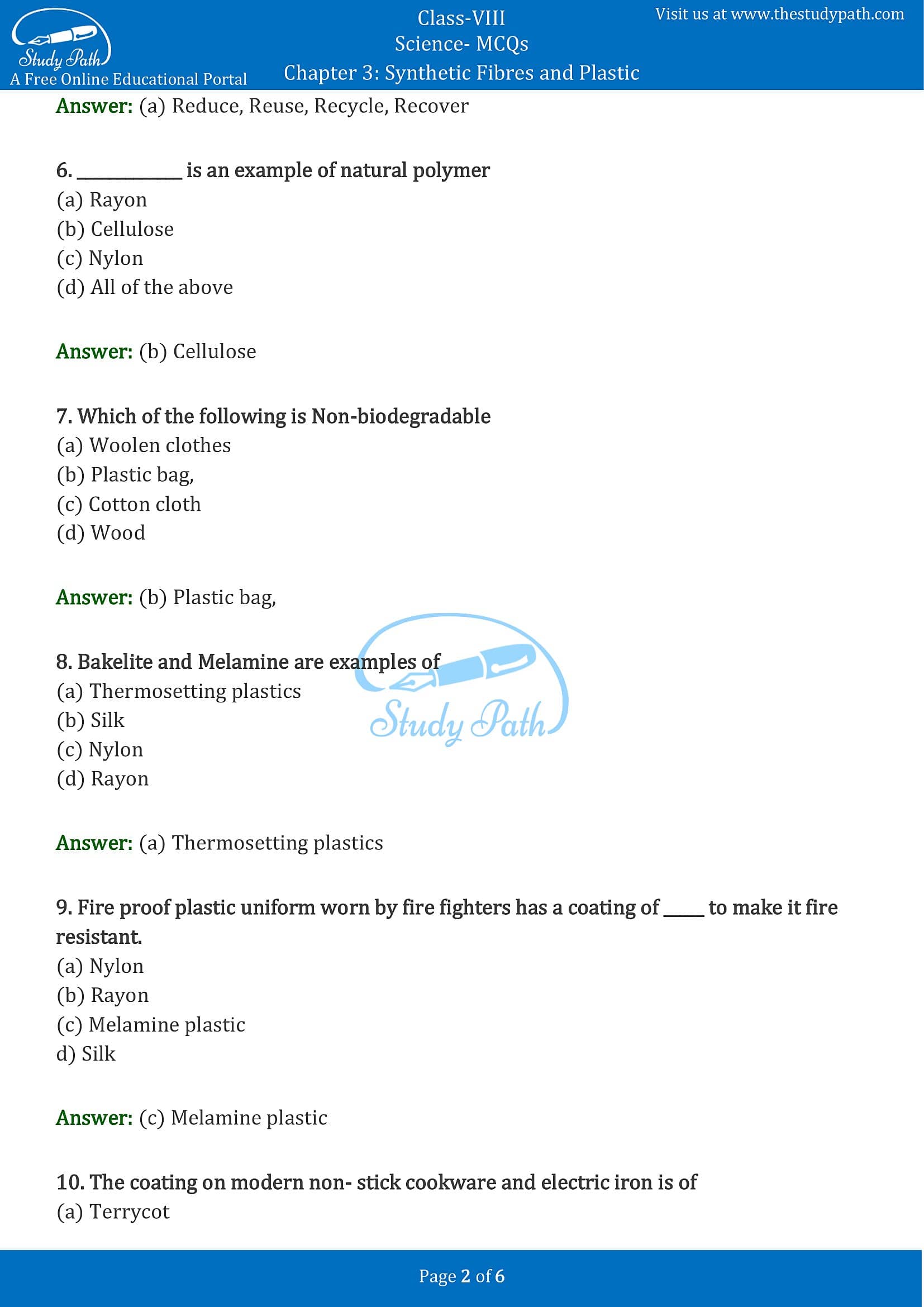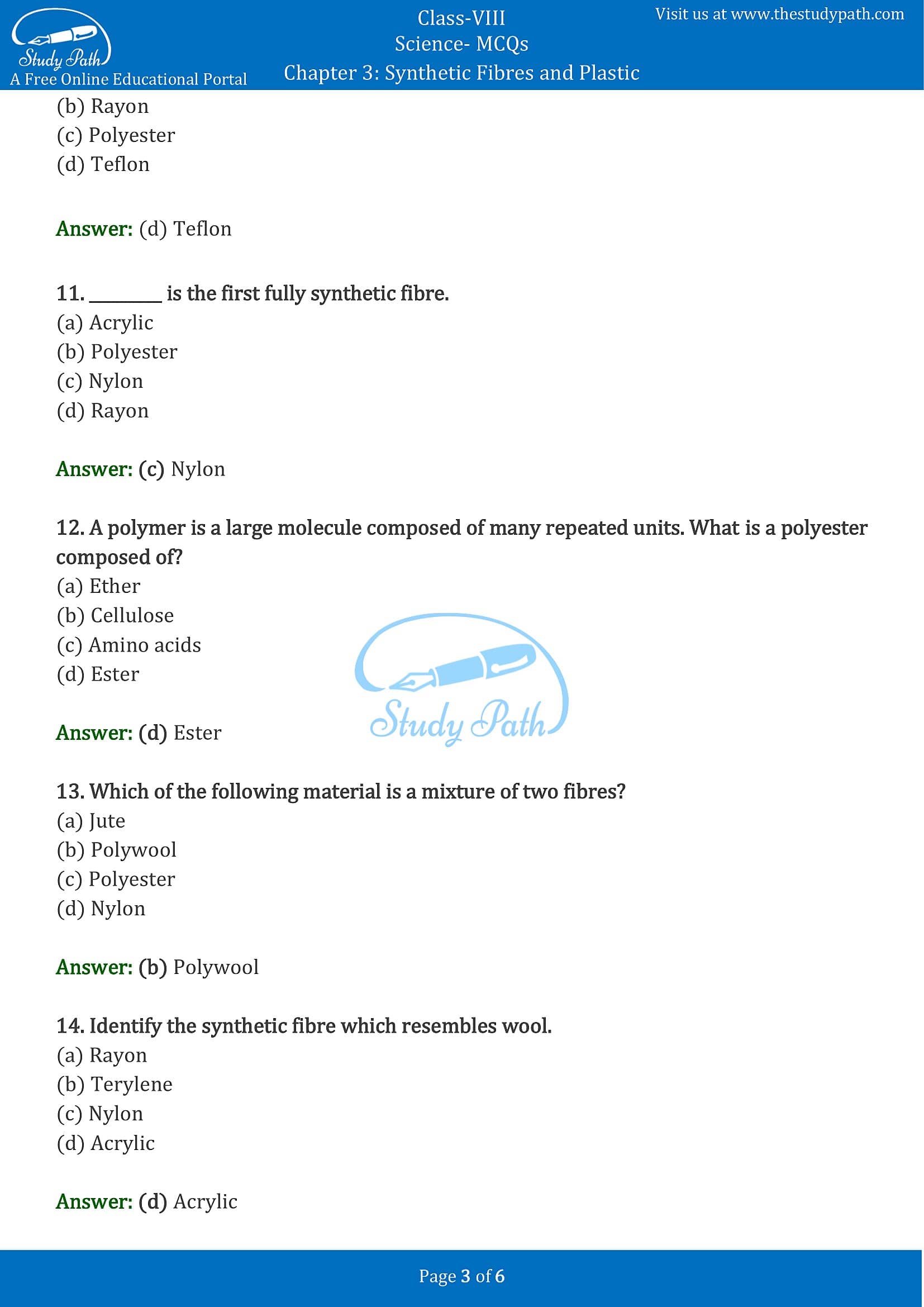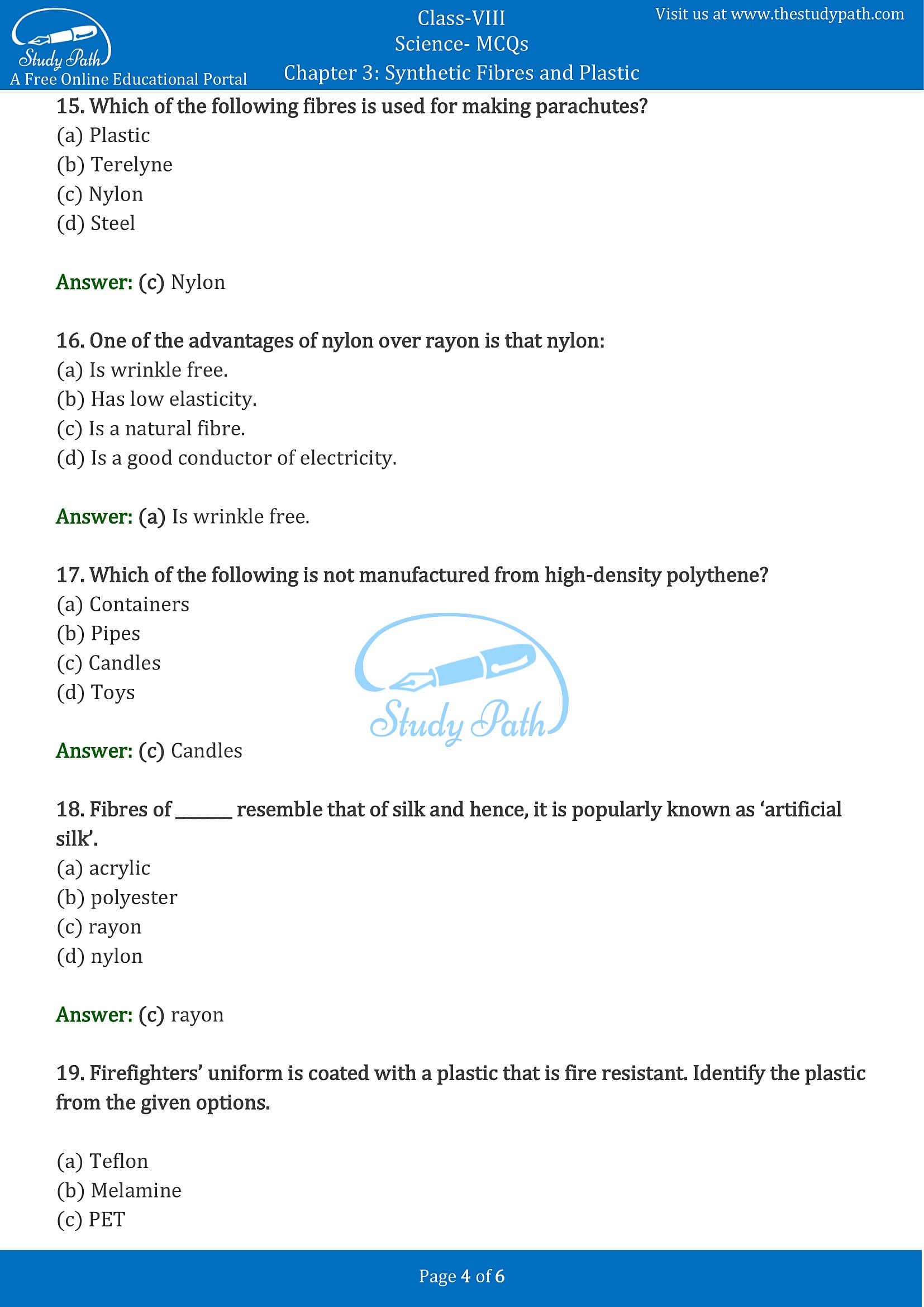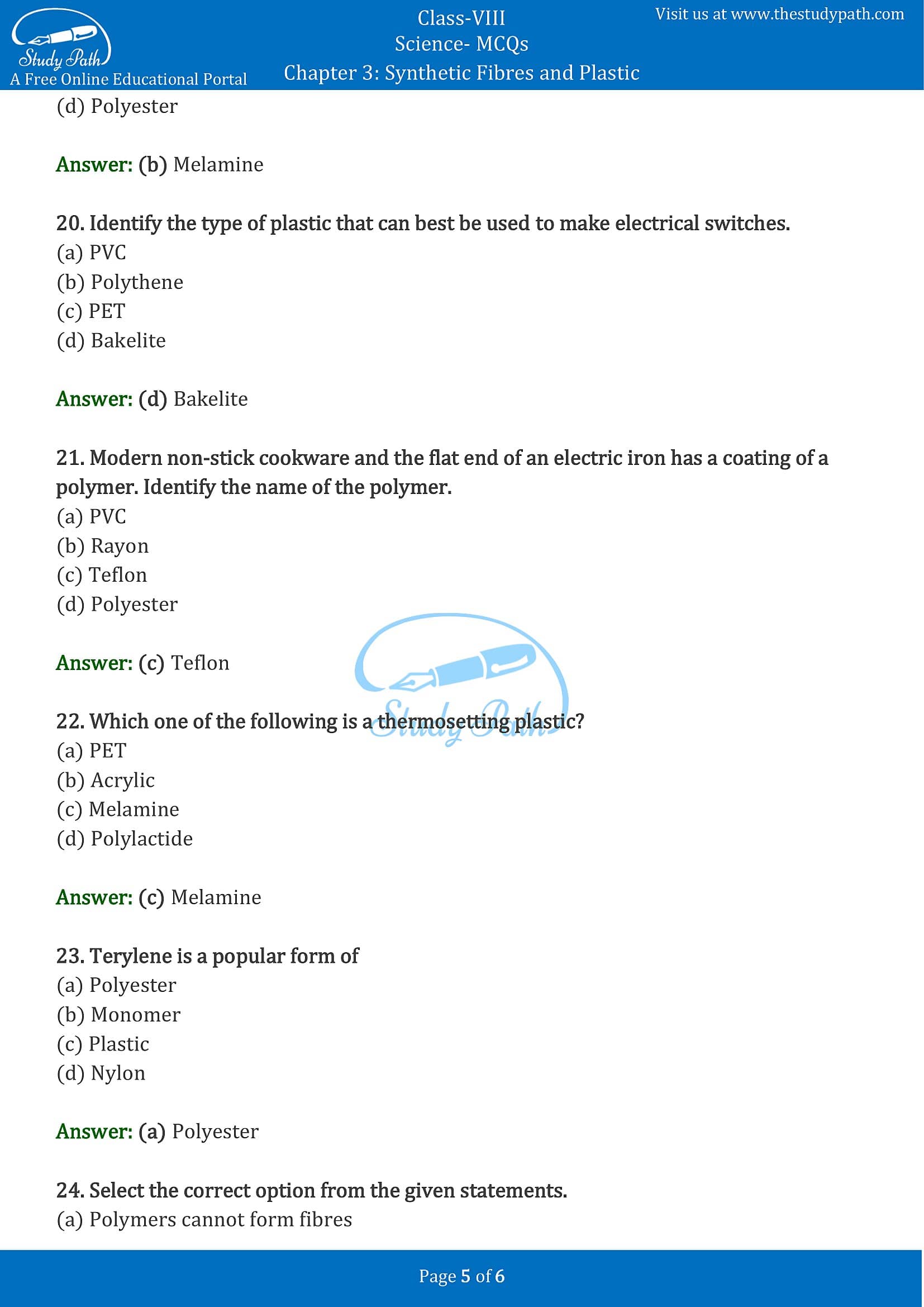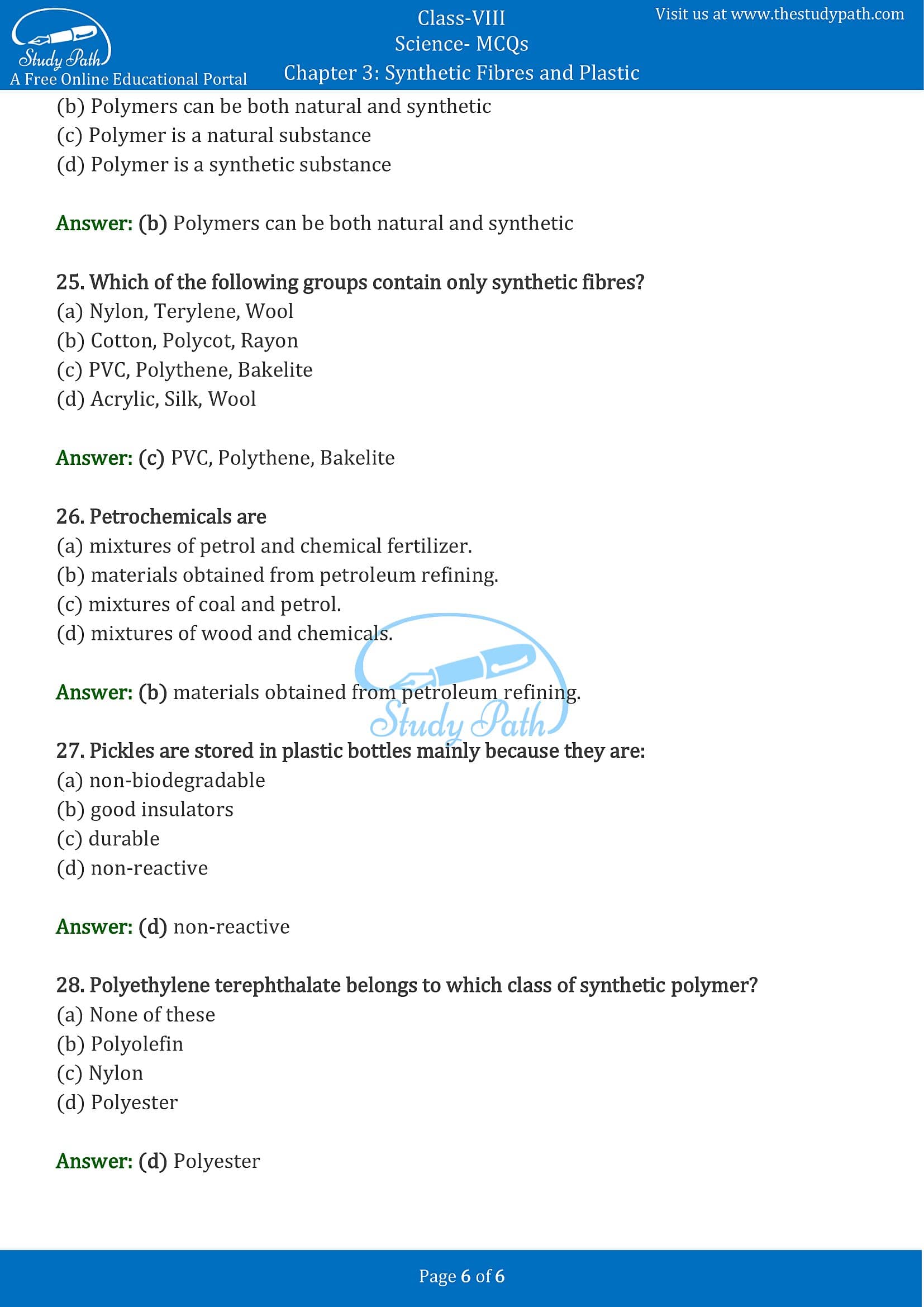Class 8 Science Chapter 3 Synthetic Fibres and Plastics MCQ with Answers
Class 8 Science Chapter 3 Synthetic Fibres and Plastics MCQ (Multiple Choice Questions) with Answers is available here in PDF format. CBSE Class 8 Science Synthetic Fibres and Plastics Objective Questions helps the students to understand the concepts thoroughly and to score good marks. Practising these MCQs will help you to answer every question that is being asked in the exams.
At Study Path, you can download PDF of Multiple Choice Questions for Class 8 Chapter 3 Synthetic Fibres and Plastics with Answers. We prepared these MCQs on the basis latest exam Pattern. Students can solve NCERT Class 8 Science Synthetic Fibres and Plastics MCQs before the exam to know their preparation level.
Synthetic Fibres and Plastics Class 8 MCQ with Answers
Multiple Choice Questions (MCQs)
1. A chain of small chemical units combined to form a large single unit is called ______
(a) Polymer
(b) Poly
(c) Polythene
(d) None of the above
Answer: (a) Polymer
2. Polythene and PVC are examples of
(a) Bio degradable substance
(b) Thermosetting plastics
(c) Thermoplastics
(d) Rayon
Answer: (c) Thermoplastics
3. Plastics which when moulded once, cannot be softened by heating. Such plastics are called ____
(a) Polythene
(b) Thermoplastics
(c) Polyster
(d) Thermosetting plastics
Answer: (d) Thermosetting plastics
4. Polycot is made by mixing two types of fibres namely
(a) Silk + Cotton
(b) Polythene + cotton
(c) Silk + Polyester
(d) Polyester + Cotton
Answer: (d) Polyester + Cotton
5. The 4 R Principle is
(a) Reduce, Reuse, Recycle, Recover
(b) Remember, reduce, Recycle, Rejoice
(c) Repeat, Rejoice, recycle, reduce
(d) None of the above
Answer: (a) Reduce, Reuse, Recycle, Recover
6. _____________ is an example of natural polymer
(a) Rayon
(b) Cellulose
(c) Nylon
(d) All of the above
Answer: (b) Cellulose
7. Which of the following is Non-biodegradable
(a) Woolen clothes
(b) Plastic bag,
(c) Cotton cloth
(d) Wood
Answer: (b) Plastic bag,
8. Bakelite and Melamine are examples of
(a) Thermosetting plastics
(b) Silk
(c) Nylon
(d) Rayon
Answer: (a) Thermosetting plastics
9. Fire proof plastic uniform worn by fire fighters has a coating of _____ to make it fire resistant.
(a) Nylon
(b) Rayon
(c) Melamine plastic
d) Silk
Answer: (c) Melamine plastic
10. The coating on modern non- stick cookware and electric iron is of
(a) Terrycot
(b) Rayon
(c) Polyester
(d) Teflon
Answer: (d) Teflon
11. _________ is the first fully synthetic fibre.
(a) Acrylic
(b) Polyester
(c) Nylon
(d) Rayon
Answer: (c) Nylon
12. A polymer is a large molecule composed of many repeated units. What is a polyester composed of?
(a) Ether
(b) Cellulose
(c) Amino acids
(d) Ester
Answer: (d) Ester
13. Which of the following material is a mixture of two fibres?
(a) Jute
(b) Polywool
(c) Polyester
(d) Nylon
Answer: (b) Polywool
14. Identify the synthetic fibre which resembles wool.
(a) Rayon
(b) Terylene
(c) Nylon
(d) Acrylic
Answer: (d) Acrylic
15. Which of the following fibres is used for making parachutes?
(a) Plastic
(b) Terelyne
(c) Nylon
(d) Steel
Answer: (c) Nylon
16. One of the advantages of nylon over rayon is that nylon:
(a) Is wrinkle free.
(b) Has low elasticity.
(c) Is a natural fibre.
(d) Is a good conductor of electricity.
Answer: (a) Is wrinkle free.
17. Which of the following is not manufactured from high-density polythene?
(a) Containers
(b) Pipes
(c) Candles
(d) Toys
Answer: (c) Candles
18. Fibres of _______ resemble that of silk and hence, it is popularly known as ‘artificial silk’.
(a) acrylic
(b) polyester
(c) rayon
(d) nylon
Answer: (c) rayon
19. Firefighters’ uniform is coated with a plastic that is fire resistant. Identify the plastic from the given options.
(a) Teflon
(b) Melamine
(c) PET
(d) Polyester
Answer: (b) Melamine
20. Identify the type of plastic that can best be used to make electrical switches.
(a) PVC
(b) Polythene
(c) PET
(d) Bakelite
Answer: (d) Bakelite
21. Modern non-stick cookware and the flat end of an electric iron has a coating of a polymer. Identify the name of the polymer.
(a) PVC
(b) Rayon
(c) Teflon
(d) Polyester
Answer: (c) Teflon
22. Which one of the following is a thermosetting plastic?
(a) PET
(b) Acrylic
(c) Melamine
(d) Polylactide
Answer: (c) Melamine
23. Terylene is a popular form of
(a) Polyester
(b) Monomer
(c) Plastic
(d) Nylon
Answer: (a) Polyester
24. Select the correct option from the given statements.
(a) Polymers cannot form fibres
(b) Polymers can be both natural and synthetic
(c) Polymer is a natural substance
(d) Polymer is a synthetic substance
Answer: (b) Polymers can be both natural and synthetic
25. Which of the following groups contain only synthetic fibres?
(a) Nylon, Terylene, Wool
(b) Cotton, Polycot, Rayon
(c) PVC, Polythene, Bakelite
(d) Acrylic, Silk, Wool
Answer: (c) PVC, Polythene, Bakelite
26. Petrochemicals are
(a) mixtures of petrol and chemical fertilizer.
(b) materials obtained from petroleum refining.
(c) mixtures of coal and petrol.
(d) mixtures of wood and chemicals.
Answer: (b) materials obtained from petroleum refining.
27. Pickles are stored in plastic bottles mainly because they are:
(a) non-biodegradable
(b) good insulators
(c) durable
(d) non-reactive
Answer: (d) non-reactive
28. Polyethylene terephthalate belongs to which class of synthetic polymer?
(a) None of these
(b) Polyolefin
(c) Nylon
(d) Polyester
Answer: (d) Polyester
At Study Path, you can also learn more about science chapter 3 Synthetic Fibres and Plastics by accessing the free exhaustive list of study materials and resources related to the chapter such as NCERT Solutions, Important Questions and Extra Questions.
